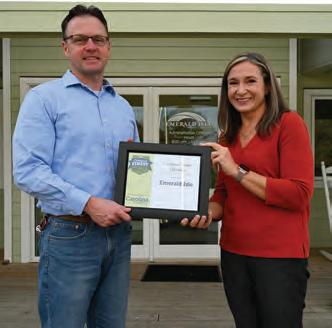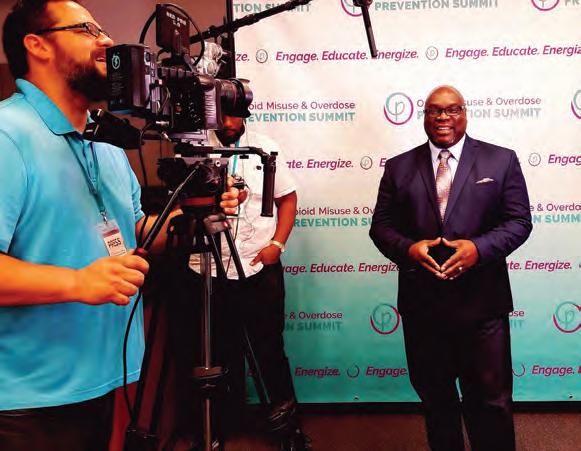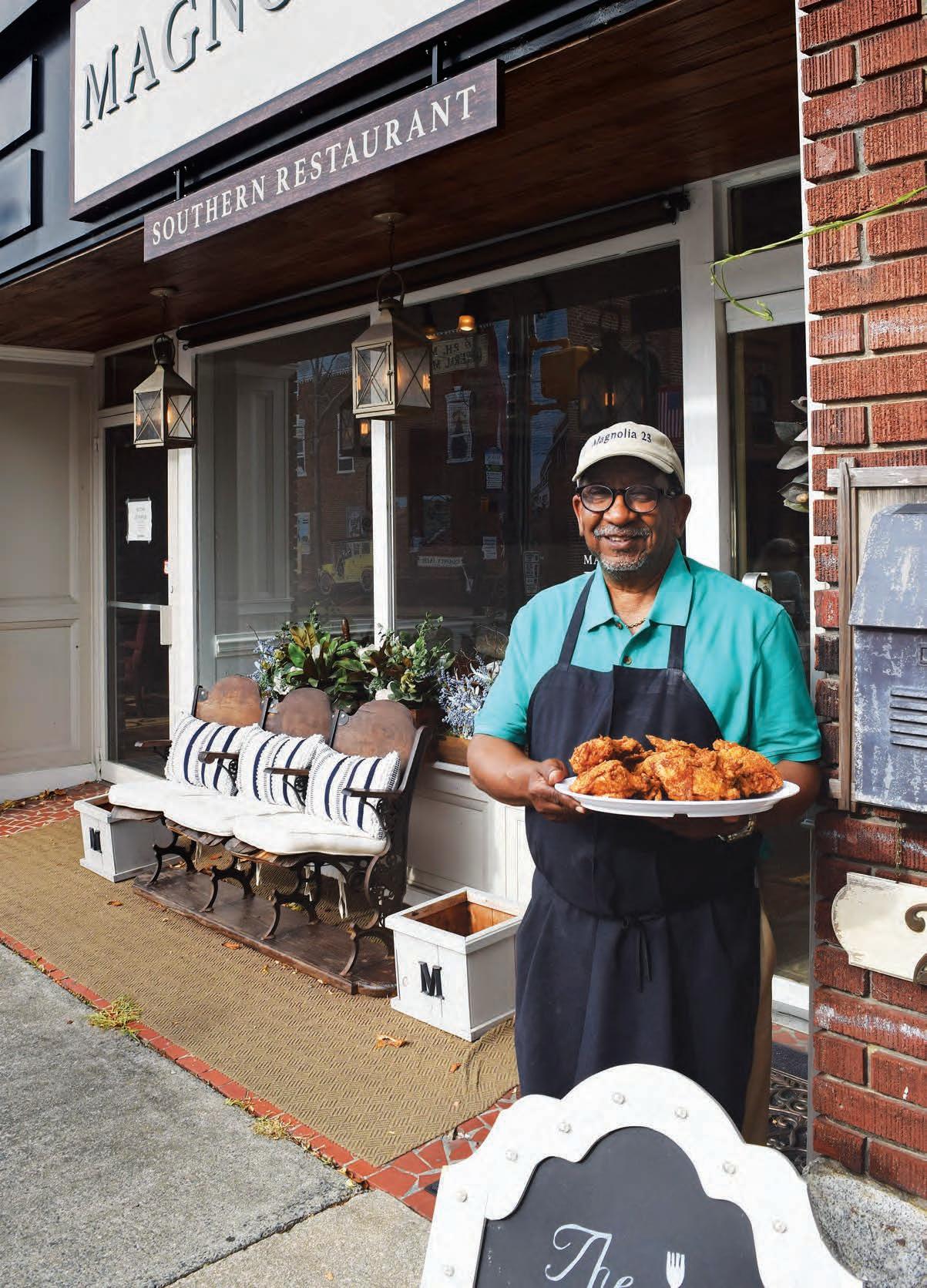
27 minute read
More Power
from 2022-02-BEMC
FEBRUARY Quick Hits
Gridiron Grub Settle in for this year’s Super Bowl on February 13 with some next-level snacks; search for winning appetizers on carolinacountry.com/recipes.
Winter-Ready Pets
If you have pets that spend time outside, adjust food servings to provide extra calories, and check to make sure water bowls don’t freeze.
Happy Feet Stash an extra pair of socks in your car’s glove box. If your socks get wet from shoveling snow or stepping in water, you have a dry pair.
Toasty and Safe Using a woodburning fireplace this winter? Clean out ashes from previous fires, and be certain the damper or flue is open before starting a fire.
NC Co-ops Participate in National Grid Security Simulation
North Carolina’s Electric Cooperatives joined several of the state’s distribution cooperatives and more than 700 planners from across the nation in participating in this year’s bi-annual GridEx VI event, a national virtual simulation to support grid security and safety.
GridEx is the largest grid security exercise in North America and is held every two years by the North American Electric Reliability Corporation’s Electricity Information Sharing and Analysis Center. It brings together industry and government leaders to simulate cyber and physical attacks on the power grid.
The November 16–17 event provided co-op staff across the state a valuable opportunity to explore response and recovery scenarios involving simulated attacks on grid infrastructure, and to exercise cooperative crisis plans.
“GridEx is an important opportunity for our leadership and staff to practice and refine our response to crisis situations that affect our core grid infrastructure,” said Scott Brame, manager of compliance and jointly owned resources, and GridEx lead planner for North Carolina’s Electric Cooperatives. “Our participation in this simulation is a part of our deep commitment to grid security and safety, both physical and digital, and showcases our cooperative commitment to readiness.”
This year’s GridEx brought together 280 industry and government organizations in the U.S., Canada and Mexico. Electric utilities, state and federal agencies, critical infrastructure cross-sector partners and supply chain stakeholders worked through response scenarios to challenge assumptions, collaborate and enhance preparedness for current and evolving threats to the grid.
The event will return in 2023 with continued participation from North Carolina’s electric co-ops.
Celebrated Finest
Some of the winners of the 2021 Carolina’s Finest awards, featured in our November 2021 issue, are served by electric cooperatives. Two such winners were the Cape Hatteras Lighthouse (Finest NC Landmark) and Emerald Isle (Finest Getaway).

Cape Hatteras Electric Cooperative EVP and General Manager Susan Flythe with Cape Hatteras National Seashore Superintendent Dave Hallac Carteret-Craven Electric Cooperative Communications Specialist Melissa Glenn with Emerald Isle Town Manager Matt Zapp



Electric Cooperative Lineworkers Gain Knowledge and Skills at Nash Community College
In 2021, 14 electric cooperative linemen completed advanced education work in the Nash Community College’s Electric Lineman Technology program. The line workers earned curriculum certificates for completing college-level credits. Teamwork and consistent training are also benefits for these students as they train with students from their sister cooperatives during each week’s class.
The program includes courses with both classroom content and practical hands-on objectives. The specially designed training field built by the North Carolina Association of Electric Cooperatives creates a training environment that allows individuals to increase skills for application when they return to their individual cooperatives. They learn skills such as overhead line construction, underground line construction and the National Electrical Safety Code. Beyond classes in line work and energy management, additional courses can be taken through the Community College System toward an associate degree such as writing and math to critical thinking, computers and communication.
Since the programs began in 1998, 23 co-op linemen have graduated with an associate degree. The community college program is supported entirely by electric cooperatives, but is also attended by linemen from Duke Energy and municipal electric systems.
In 2021, 396 co-op employees attended the NC Electric Cooperatives’ Job Training & Safety Technical Training Schools at Nash Community College, and more than 500 have registered to attend in 2022. Associate Degree
Rutherford EMC Matthew Harshman
Spring 2021 Advanced Certificate Recipients
(17 Course-Hour Credits) Pee Dee Electric Jesse Puckett Surry-Yadkin EMC Nick Newman
Summer 2021 Advanced Certificate Recipients
(17 Course-Hour Credits) Edgecombe-Martin County EMC Alton Lewis Halifax EMC Cody Pleasant Rutherford EMC Matthew Harshman
Fall 2021 Advanced Certificate Recipients
(17 Course-Hour Credits) Four County EMC Lee Bain
Halifax EMC Branden Edwards
Lumbee River EMC Joshua Oxendine Roanoke Electric Cooperative Robbie Stallings South River EMC Nathaniel Lucas Daniel Purvis
Tideland EMC Joshua Dunbar Robert Shively Tri-County EMC James Cozine
Journey To Save A Life
A casual conversation between co-workers led to a lifesaving surgery
By Catherine O’Dell
On July 13, 2021, I had the honor to be a living kidney donor for Susan Green. Susan is the wife of a South River EMC co-worker, Dana Green. One day, Dana mentioned that his wife has a rare genetic kidney disease called Focal Segmental Glomerulosclerosis, and that she would soon need dialysis and a transplant. This kind of conversation often leaves you feeling helpless, but I knew instantly that I could help. The exchange stayed in my mind and on my heart. A few days later, I asked about Susan’s blood type: A-positive, same as mine.
I couldn’t stop thinking about Susan. I did some research and found that nearly 750,000 Americans are battling end-stage renal disease, according to Kidney.org, and that more than 100,000 people in the United States are waiting for a kidney transplant. Tragically, 12 people die daily waiting for a life-saving kidney. The good news is that about 22,300 get a kidney and a new lease on life. There are approximately 6,500 transplants from living donors annually, although the majority of transplanted kidneys are from deceased donors. Organs from living donors provide a greater life span for the recipient: A kidney from a living donor lasts 12 to 20 years, while a kidney transplanted from a deceased donor lasts eight to 12 years.
These startling statistics helped me to become more focused and inspired to help. I spoke to a friend who had donated a kidney, as well as one who had received a lifesaving kidney. Both served to motivate me and were instrumental in my decision. I have been blessed with good health, and I knew that it was time to help someone else. I believe I was placed in the right place at the right time.
Once I told Dana that I wanted to be considered as a donor, she called the UNC Hospitals Jason Ray Transplant Clinic to get the ball rolling immediately.
“When Dana told me someone wanted to give me a kidney, I was so grateful, and I felt like my feet would never touch the ground,” Susan said.
The first step was a blood sample to ensure our blood type and subtypes match. We matched.
I spent two days at UNC Hospitals undergoing a series of scans and tests to ensure my kidneys were healthy and functioning properly, and to confirm that I was healthy enough to undergo surgery.
I stayed in touch with Susan every step of the way.
Once all results were returned, we learned everything looked good — except I had to lose some weight before being cleared for surgery. I started walking and dieting. It is amazing how dedicated you become when someone else’s life depends on your success. In the meantime, Susan began dialysis, a step she was hoping to avoid, but ultimately made her healthier for the surgery.
The weight and I had parted ways, and it was time for the surgery. We checked into the hospital early one morning, and by midday both of our lives were changed and we are forever bound to one another.
I spent two days in the hospital and returned to work two weeks later.
The doctors, nurses and staff at the Jason Ray Transplant Clinic are passionate about the care they provide, so much that I trusted them with my life. My life can go on without much difference, but Susan’s life is changed forever. It is this point where Susan’s story begins.
“I have been given a second chance for life,” Susan said. “I would encourage those on the transplant list to stay strong, and don’t give up! Spread the word that you need a kidney, because there are amazing people who might want to donate.”

Catherine and Susan after surgery
Catherine O’Dell, CCC, is vice president of Member Services & Public Relations for Dunn-based South River EMC.
How you can help
Saving a life can be as simple as donating blood, registering to become an organ and tissue donor upon your death, or by being a living donor of bone marrow, part of your liver or one kidney. Visit donatelife.net for complete information on donation options.
It was bitter cold, and a misty rain dogged the line of people outside a nondescript building near Cape Fear Hospital in Fayetteville.
In an archipelago of outpatient doctors’ offices that cordons the hospital, Acadia Healthcare’s Comprehensive Treatment Center is frequented by professionals, stayat-home parents, insurance agents, wounded veterans — no one has the same story, but all shared the same burden as they stood together in line one early December morning. All struggled with substance use disorders, a part of the nation’s ongoing opioid epidemic.
From 2000 to 2020, more than 28,000 North Carolinians lost their lives to drug overdose, according to the NC Department of Health and Human Services, and annual suspected overdose deaths continue to climb (see chart). But communities are banding together to help those in need, providing several potential paths to recovery.
From recovery to support
Louis Leake, clinic director at the Comprehensive Treatment Center — the largest opioid addiction treatment facility in the state — is a U.S. Army combat veteran, a pastor, and a sought-after speaker on the opioid crisis that has been gripping America’s society for over three decades. His office is small, tucked in the back of the building, but it gives him the opportunity to see each client pass as they exit. He knows many and has counseled more than a handful of them. No one demographic describes them. No archetypal story.
“We have three generations of families who attend our clinic,” he says, emphasizing that addiction to opioids is not limited to the young, or the poor, or the destitute.
Substance abuse is not limited to syringes or illicit drugs, either. “Prescription pain medications, opium, heroin and fentanyl are all opioids and affect the brain in essentially the same way,” writes Barbara AndrakaChristou, author of “The Opioid Fix.”
Louis was a paratrooper who logged more than 18 years of service and countless parachute jumps. Then, a parachuting accident left him paralyzed, with rods and screws holding his back and legs together. The pain medicine he was prescribed worked, though a creeping dependence was almost imperceptible.
“My pastor asked me to help the young men who were living in a halfway house our church ministered to,” Louis says in explaining his first step to realizing his addiction. “I heard these guys’ stories, and I thought: that sounds far too similar to my own story.”
Louis’ path to recovery was spiritual — as he puts it, he went on a spiritual retreat and came back different. He researched opioid addiction and began taking classes in a counseling program offered by the local community college. In recovery, he began counseling others.
Kennard Dubose, assistant professor in the Department of Social Work at UNC Pembroke, traces the history of addiction counseling from its earliest beginnings in Alcoholics Anonymous.
“In the past, people in recovery were the counselors for others entering recovery,” he explains. The profession of substance abuse counseling has matured since then. Now certification programs are plentiful across the states.

Suspected Overdose Deaths*
2018–2021
+26%
2,554 2,688 +5% 3,132 +15% YTD (Jan–Nov) Full year
2,351 2,471 2,844 3,595 *Estimate of statewide medical examiner system overdose deaths; the majority become confirmed as poisoning deaths. Percent change represents year-to-date (YTD) suspected overdose deaths compared to YTD total of previous year, based on available data at time of publication. Source: NC Office of the Chief Medical Examiner
Treatment centers have also proliferated. At first, abstinence-based treatments centers were the only centers available. Now, medicated assistant treatment centers are available in nearly every county of North Carolina. Abstinence-based treatment programs follow a model that is similar to Alcoholics Anonymous’ 12-step program. The people in recovery stop taking the drugs, and work through withdrawal with counseling and support from peers. Medicated assistance treatments also involve counseling and peer-support, but these treatment programs curb the symptoms of withdrawal by reducing their severity.
Both treatments work, but patients need to get to the treatment first. More local resources, as well as work to remove the stigma of substance use disorders, are making a difference.

Mobilizing community
Drug Free Moore County (DFMC), which has received funding support from Central Electric, the electric cooperative based in Sanford, is a nonprofit coalition with the mission of providing educational resources, treatment information and addiction recovery support. It was organized in 1989, but with the onset of the opioid crisis has ramped up its efforts from prevention programs for school students to providing recovery support to families who are affected by substance use disorder.
DFMC Director Karen Wicker recently opened a community recovery center called Moore ReCreations in Carthage to help provide a variety of support and resources to individuals and families. The center’s goal is to help individuals “recreate” themselves during their recovery.
Moore ReCreations provides peer support services, a safe syringe program, and recovery support groups in person and via Zoom through the Moore County Detention Center. Future plans include a family support group, a reentry support group for inmates, recovery yoga, a community garden, sewing classes and other opportunities for growth and healing. DFMC is also working to provide a medically assisted treatment (MAT) program at the center through a contract with a locally established MAT program.
Karen is no stranger to the ravages of the opioid crisis. Like many, she has personal experience with opioid addiction in her family. It started innocently enough, with her daughter’s adolescent anxiety issue bringing drugs into her life as doctor-prescribed treatment.
“This, combined with peer pressure and the grief suffered from the death of her brother when she was 18, started a slow but downward spiral,” Karen explains. “There are different paths to substance use disorder, and there are different paths to recovery, too. As a parent it is hard to pinpoint what is going on until something dramatic happens.”
For Karen, it was when she received one of the worst phone calls any parent could imagine: her daughter had been air-lifted to Chapel Hill following a head-on collision. Her status was unknown. It wasn’t until several weeks later they learned substances were involved.
“When my daughter had started treatment, we did not know that, unfortunately, relapse is a part of this disease. The journey of recovery wasn’t always easy or pleasant as a parent of a loved one suffering,” Karen says. Her daughter has started a new life after being in recovery for several years. “Friends, family and people in general do not understand the heartbreak of not being able to help the one you love, or to even talk about it. Stigma is such a huge factor in families not getting the help and support they need.”
Louis Leake, who often speaks on the opioid crisis, at the 2019 Opioid Misuse and Overdose Prevention Summit in Raleigh
Taking the first step
The most important work is to remove the stigma of substance use disorders. For some, the perceived shame of addiction treatment keeps them from seeking help until it is too late.
Macon Moye, former vice president and general manager of WRFX’s John Boy and Billy network in Charlotte, first began taking pain medication for chronic knee pain. What was occasional use became daily, then became paired with alcohol. For years he refused to seek treatment until he was eventually hospitalized for more than three months.
“Two decades of drug and alcohol abuse takes a toll on your organs. They had shut down. Quit working,” he recalls of his 2012 near-death experience. Now, he is nearly a decade into recovery and supports others who are battling through recovery and the stigma associated with it through work at Chloe’s Place in Southern Pines (chloesplace.net) and at the Raleigh-based Welwynn Outpatient Center (welwynn.com).
Macon urges people who are suffering from a substance use disorder to seek treatment: “Life is too short to live dulled and desensitized.”
Carolina Country Contributing Editor Gordon Byrd is a veteran who works for UNC Pembroke. While not working or writing, he spends most of his time with family and church.
Seeking help
Are you or someone you know struggling with a substance use disorder? Contact the Alcohol and Drug Council of North Carolina at 800-688-4232 or alcoholdrughelp.org.
“Seas” Life’s Loving Moments with Your Sweetie!
PERSONALIZE IT FREE!
Shown smaller than approximate size of 61/2" wide

Celebrate your love for the beach — and each other! — with “Just Me And You With An Ocean View,” an irresistible Precious Moments® porcelain keepsake you can PERSONALIZE!
Entirely handcrafted of fine bisque porcelain!
Every detail is crafted of bisque porcelain and hand-painted, from this cute couple’s relaxed pose as they hold hands, to their colorful chairs and her tropical drink. And with their names written in the “sand,” this loving pair is “shore” of one thing — they were meant to be together forever!
Reserve it in your name today risk-free!
Send no money now to request your personal edition of “Just Me And You With An Ocean View.” Simply return the coupon and note the names you wish to include for the personalization. The issue price is payable in three payments of $36.66*; with only the first billed prior to shipment. Our 365-Day Guarantee assures your satisfaction or your money back, so there’s no risk to you. Reply today!
FOLLOW US ON
Fastest way to order:
HamiltonCollection.com/Ocean
MAIL TO:
09-08006-001-BI4
❑ YES! Please accept my order for “Just Me And You
With An Ocean View” as described in this announcement.
Fill in the two FIRST NAMES as you want them to appear:
GIRL’S NAME as you’d like it to appear.
BOY’S NAME as you’d like it to appear.
Send No Money Now!
Name__________________________________________________ (Please print clearly.) Address________________________________________________ City_________________________ State______Zip_____________ Email (Optional)__________________________________________ Signature_______________________________________________ Orders subject to acceptance.
No Taste Like Home
By Bridgette A. Lacy
On work days, Don Simmons starts at 6 a.m. ordering supplies, scheduling work shifts, and writing the daily menu on the chalkboard at Magnolia 23, his Southern cuisine restaurant in downtown Asheboro.
Throughout the day, he may wash dishes, cook the delicious pan-fried chicken, take orders and greet every customer that comes through the door of the cozy space that reminds you of your grandmother’s dining room with mirrors and pictures on the wall.
Everybody ranging from blue collar workers, families, business people and tourists eat there.
“His food is wonderful,” says Asheboro Mayor David Smith. “His fried chicken has been recognized nationally.”
Magnolia 23 opened in 2009, the same year Don retired from his position as a supervisor for Energizer Battery Inc. in Asheboro.
“The economy was rock bottom,” Don says. “But as soon as we opened, we did pretty good.”
Word of the made-from-scratch soul food and the great hospitality kept customers coming through the door. His wife, Doris, makes the melt-inyour-mouth cornbread and often runs the cash register. And ownership of the business has been passed to daughters Brittany Simmons, a physician assistant in Greensboro, and Crystal Simmons, an associate professor at SUNY Geneseo.
Don is well known beyond his restaurant and volunteers on his days off. His latest service project is organizing a free Crowder Baseball Camp, named for the late Chester Crowder of Asheboro.
“We want every kid to have a chance to play,” Don says.

Bridgette A. Lacy (bridgettelacy@att.net) is the author of “Sunday Dinner: A Savor the South cookbook.” Don Simmons
Claim to fame: Home cookin’. Magnolia 23 was voted #63 on a list of “America’s 75 Best Fried Chicken Spots” by the Daily Meal, a website dedicated to food news. Most popular dishes: Grilled pork chops, country style steak, fried catfish, mac and cheese, collards and candied yams; desserts include fried apple pie and Hershey bar cake: a chocolate cake with white icing and pieces of Hershey’s candy sprinkles on it. Read the full version of this article at carolinacountry.com/extras
FEBRUARY 2022
Two Options that Reduce Peak Demand and Lower Your Bill!
These demand control options help you shift your usage from times of peak demand, which 1) reduces your energy bill and 2) controls wholesale power costs, which 3) helps keep rates as low as possible.
Bring Your Own Thermostat: If you have or are considering getting a smart thermostat, we have a program designed just for you! Bring Your Own Thermostat offers you a $50 bill credit when you enroll your thermostat, and a $4 monthly credit each month. Enrolling allows BEMC to make brief changes to your HVAC setting by three degrees on a limited number of peak demand periods, which typically occur on the hottest days of summer and coldest days of winter.
Time-of-Use Rate Option: The Time-of-Use (TOU) rate option offers you a lower rate for electricity when demand on our system is low, balanced with a higher rate when demand on our system is high. You save money by shifting your energy consumption to times when demand on our system is low.
By avoiding using high-wattage appliances and adjusting your thermostat during the hours of 6 a.m. to 9 a.m. weekdays in the winter, and from 2 p.m. to 6 p.m. weekdays in the summer, you’ll lower your bill. That’s because you’ll pay a lower rate than our standard rate all other times, and a much lower rate from 10 p.m. to 5 a.m. all year-round. We recommend installing a timer on your water heater and adding a programmable thermostat to your HVAC system to maximize success with this rate option.
Please note these options cannot be used in combination. For more information on these options visit bemc.org/connect2save-byot and bemc.org/time-of-use, call (800) 842-5871, or stop by any office with questions and to enroll.

Because You Want to Know...
Each month we’ll answer a question that has been on a member’s mind, because we bet you might also want to know. Send your questions to brookes.versaggi@bemc.org.
è QWill you be incorporating more renewables into our energy mix, and toward what end?
– Alice in Whiteville
è A Yes. A primary goal of our Brighter Future initiative is a 50% reduction in carbon emissions by 2030, and net zero carbon emissions by 2050, and we’re going to do that with renewables, as well as demand management technologies and energy efficiency. Making the adoption of these resources as easy as possible for our members is also part of our strategy, through information, program design, and rates. We believe that for energy to be sustainable, it must continue to be affordable.
numbers Power in
Electric co-ops own 42 percent of America’s distribution lines covering three-quarters of the country.
A Conversation with Members on Beat the Peak
We’ve been asking members to voluntarily limit energy usage during Beat the Peak alerts, issued when we are expecting peak demand. In the winter the timeframe is usually from 6 a.m. – 9 a.m. We ask for participation because the rate we pay for wholesale power for any given month is based on the highest hour of peak demand for that month, and we have the power to collectively reduce that rate by lowering that peak. This helps avoid or reduce future rate increases. We talked to members Jimmy Green and Heather Smith, who are also BEMC employees, about why it’s important to them.
Q: How, and why, do you participate in Beat the Peak alerts during the winter?
Jimmy: Since we usually know about the alert by email or post the evening before, I make a plan to participate. I normally program my thermostat to lower the temperature while I’m sleeping anyway, and for Beat the Peak alerts I forgo having it raise the temperature when I get up. I have it go back to regular settings at 9 a.m. instead. If it’s a weekday, I do what I need to do to get ready for work, but nothing extra like running a load of laundry or dishes. If it’s on the weekend, same thing, nothing extra until 9 a.m. I might stick a note on my fridge the night before to remind myself.
Heather: Not everyone wants to adjust their thermostat. I participate by holding off on using major appliances during that time too. It’s collectively what we do that makes a difference. It’s true that if most people take at least some action during the alert, even turning off one lightbulb they don’t really need at the time, we can make a big impact on our power costs that month.
Jimmy: That’s right. The good thing is, the BEMC system has the capacity and is available when we need it, the power supplied during peak times just comes at a cost to all of us. I participate to reduce the peak demand and reduce cost. Our individual actions can help keep everyone’s rate as low as possible.
Heather: Me too, and I’ve gotten my family on board. It’s a voluntary program, and one that makes a big difference without too much effort. Think about starting a text group with your friends, reminding them to participate. It’s all about power in numbers.
If you’re not receiving Beat the Peak alerts and would like to, please call (800) 842-5871.

Jimmy Green sticks a note on his refrigerator to remind him about a Beat the Peak alert
College Scholarship applications due March 17
Brunswick Electric will award two scholarships of $5,000 each to two high school seniors, one from Brunswick County and one from the Columbus County area, in the spring. Completed applications must be submitted through the student's guidance counselor by March 17. For more information visit bemc.org/scholarship-highway.
Top Ten Reasons Why You Should Consider an Electric Vehicle
1Electricity is cheaper than gas. When you drive an EV your fuel costs are about half of what they would be driving an internal combustion vehicle, and the savings can be even greater thanks to super-offpeak charging rates. This can mean multiple thousands of dollars over the life of your EV.
2Less maintenance. Electric motors have fewer parts; you don’t have to worry about changing oil or transmission fluid, spark plugs, fuel filters or drive belts. And brakes need to be replaced less often due to regenerative braking.
3They are fun to drive. EVs offer instant torque so you can enjoy smooth and rapid acceleration and deceleration, and their low centers of gravity improve handling and responsiveness.

4You might get a tax break. The Federal government offers a tax credit of up to $7,500 on some new EVs.
5There’s an EV for every lifestyle. Families, commuters and those who use their vehicle for work will soon find a variety of trucks, sedans and SUVs available. And manufacturers will be increasing their offerings.
6There are used EVs available. With prior owners having purchased them with a tax credit, they are more affordable on the used market, and there are lease turn-ins available as well.
7Range anxiety is in the rear-view mirror. Battery technology has improved to the point that most allelectric vehicles can go 200 miles, and many can go more, on a charge. Even if you have a long commute, you’ll still have enough charge left for after-work activities.
8There are more than 600 public charging stations in North Carolina. And the network is expanding. PlugShare, Open Charge Map and Alternative Charging Stations are three free apps that can point you to the one nearest you and can make planning in or out-of-state trips easy.
9No more stopping at gas stations. With an all-electric vehicle, you can leave the house each morning fully fueled.
10 EVs are better for the environment. By driving an EV you’re helping to reduce exhaust emissions. As you cruise silently, imagine how much quieter the world will be when everyone is driving an EV.
Sports Camp Scholarship Applications Due March 31
Each year, BEMC provides two full scholarships to area students to attend overnight basketball camp on college campuses in the summer. This program is open to rising sixth and seventh graders in our service territory, and applicants will be judged on their academics, extracurricular activities and an essay.
Young men can apply to attend the Carolina Basketball School at the University of North Carolina-Chapel Hill, and young women can apply to attend the Wolfpack Women’s Basketball Camp at NC State University in Raleigh.
All applications must be postmarked by March 31. For more information visit bemc.org/ sports-camp-scholarships.


2019 recipient Emily Price with NC State Head Coach Wes Moore

2019 recipient Josiah Johnson with UNC Head Coach Roy Williams.
Community Grants Applications Due February 15
Eligible groups may apply for grants up to $2,500 each year for projects that fall into these five key areas: è Family services è Civic and Community
Programs è Cultural and Arts Programs è Emergency Services è Economic Development
For more information and to apply, visit bemc.org/ community-grants.

CUSTOMER SERVICE (800) 842-5871 | OUTAGE REPORTING (800) 682-5309
Shallotte (910) 754-4391 Southport/Oak Island (910) 457-9808 Whiteville (910) 642-5011 P.O. Box 826, Shallotte, NC 28459 www.bemc.org email: newsletter@bemc.org
AUTO BILL PAYMENT 24/7 (866) 934-6830
BOARD OF DIRECTORS David Gore Larry Fowler
PRESIDENT SECRETARY TREASURER
Frederick Tedder
VICE PRESIDENT Calvin Duncan
ASST. SECRETARY TREASURER Deborah Ahlers
Moses Herring Glenn Humbert Perry Sellers Dan Strickland John Ward
This institution is an equal opportunity employer and provider.
Joshua L. Winslow
CEO/GENERAL MANAGER Dennis Worley
ATTORNEY
Upper Class Just Got Lower Priced
Finally, luxury built for value— not for false status
Until Stauer came along, you needed an inheritance to buy a timepiece with class and refinement. Not any more. The Stauer Magnificat II embodies the impeccable quality and engineering once found only in the watch collections of the idle rich. Today, it can be on your wrist.
The Magnificat II has the kind of thoughtful design that harkens back to those rare, 150-year-old moon phases that once could only be found under glass in a collector’s trophy room.
Powered by 27 jewels, the Magnificat II is wound by the movement of your body. An exhibition back reveals the genius of the engineering and lets you witness the automatic rotor that enables you to wind the watch with a simple flick of your wrist.
It took three years of development and $26 million in advanced Swiss-built watchmaking machinery to create the Magnificat II. When we took the watch to renowned watchmaker and watch historian George Thomas, he disassembled it and studied the escapement, balance wheel and the rotor. He remarked on the detailed guilloche face, gilt winding crown, and the crocodile-embossed leather band. He was intrigued by the three interior dials for day, date, and 24-hour moon phases. He estimated that this fine timepiece would cost over $2,500. We all smiled and told him that the Stauer price was less than $100. A truly magnificent watch at a truly magnificent price!
Try the Magnificat II for 30 days and if you are not receiving compliments, please return the watch for a full refund of the purchase price. The precision-built movement carries a 2 year warranty against defect. If you trust your own good taste, the Magnificat II is built for you. Stauer Magnificat II Timepiece $399* Offer Code Price $99 + S&P SAVE $300! You must use the offer code to get our special price.
1-800-333-2045

Your Offer Code: MAG620-08 Rating of A+
Stauer ®
14101 Southcross Drive W., Ste 155, Dept. MAG620-08 Burnsville, Minnesota 55337 www.stauer.com
† Special price only for customers using the offer code versus the price on Stauer.com without your offer code.
The Stauer Magnificat II is powered by your own movement







